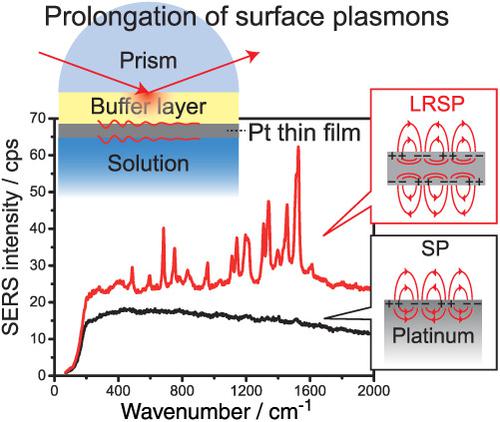当前位置:
X-MOL 学术
›
J. Raman Spectrosc.
›
论文详情
Our official English website, www.x-mol.net, welcomes your feedback! (Note: you will need to create a separate account there.)
Long‐range surface plasmon enhanced Raman spectroscopy at highly damping platinum electrodes
Journal of Raman Spectroscopy ( IF 2.5 ) Pub Date : 2020-06-10 , DOI: 10.1002/jrs.5925 Soma Ikegaya 1 , Kenta Motobayashi 1 , Katsuyoshi Ikeda 1, 2
Journal of Raman Spectroscopy ( IF 2.5 ) Pub Date : 2020-06-10 , DOI: 10.1002/jrs.5925 Soma Ikegaya 1 , Kenta Motobayashi 1 , Katsuyoshi Ikeda 1, 2
Affiliation

|
Knowledge of electrode/electrolyte interfacial structures is the first step toward a better understanding of electrochemical reactions. Among several surface‐specific vibrational spectroscopy, plasmonic enhancement of Raman scattering signals is recognized as a powerful method for in situ observation of electrochemical metal/dielectric interfaces. However, the applicability of this technique is governed by the resonance behavior of surface plasmons at the interface. Although platinum group metals are one of the most interesting materials for electrocatalysis, surface plasmon polaritons are largely damped at these surfaces by their localized d‐electrons. Thus, the plasmon enhanced Raman spectroscopy is normally useless for studying such catalytic surfaces. In this work, the attenuation of surface plasmons at highly damping Pt surface is reduced using a symmetric slab mode, which is a strongly coupled surface plasmons excited at both interfaces of a thin metal film. The prolonged propagation of surface plasmons in this double‐interface configuration leads to a substantial enhancement of local fields even at lossy Pt surface. The theoretical calculation indicates that the enhancement factor of Raman scattering intensity can reach the order of 104 at Pt/solution interfaces in this coupled plasmon mode. We experimentally demonstrate that Raman scattering signals are indeed significantly enhanced at Pt surface under electrochemical conditions. This strategy provides us a novel surface‐specific spectroscopic method for the molecular‐scale investigation of electrocatalytic reactions.
中文翻译:

高阻尼铂电极的远程表面等离子体激元增强拉曼光谱
电极/电解质界面结构的知识是迈向更好地了解电化学反应的第一步。在几种特定于表面的振动光谱中,拉曼散射信号的等离子体增强被认为是原位观察电化学金属/介电界面的有效方法。但是,此技术的适用性受界面处表面等离子体激元的共振行为支配。尽管铂族金属是用于电催化的最有趣的材料之一,但表面等离振子极化子在这些表面上的局部d电子在很大程度上被阻尼。因此,等离激元增强拉曼光谱通常对于研究这种催化表面是无用的。在这项工作中,使用对称平板模式可以降低在高阻尼Pt表面上的表面等离子体激元的衰减,对称平板模式是在金属薄膜的两个界面处激发的强耦合表面等离子体激元。在这种双界面结构中,表面等离子体激元的长时间传播导致即使在有损的Pt表面上,局部场也大大增强。理论计算表明,拉曼散射强度的增强因子可以达到10的数量级。在这种耦合等离子体激元模式下,Pt /溶液界面为4。我们实验证明,在电化学条件下,拉曼散射信号确实在Pt表面显着增强。该策略为我们提供了一种用于电催化反应分子规模研究的新型表面特异性光谱方法。
更新日期:2020-06-10
中文翻译:

高阻尼铂电极的远程表面等离子体激元增强拉曼光谱
电极/电解质界面结构的知识是迈向更好地了解电化学反应的第一步。在几种特定于表面的振动光谱中,拉曼散射信号的等离子体增强被认为是原位观察电化学金属/介电界面的有效方法。但是,此技术的适用性受界面处表面等离子体激元的共振行为支配。尽管铂族金属是用于电催化的最有趣的材料之一,但表面等离振子极化子在这些表面上的局部d电子在很大程度上被阻尼。因此,等离激元增强拉曼光谱通常对于研究这种催化表面是无用的。在这项工作中,使用对称平板模式可以降低在高阻尼Pt表面上的表面等离子体激元的衰减,对称平板模式是在金属薄膜的两个界面处激发的强耦合表面等离子体激元。在这种双界面结构中,表面等离子体激元的长时间传播导致即使在有损的Pt表面上,局部场也大大增强。理论计算表明,拉曼散射强度的增强因子可以达到10的数量级。在这种耦合等离子体激元模式下,Pt /溶液界面为4。我们实验证明,在电化学条件下,拉曼散射信号确实在Pt表面显着增强。该策略为我们提供了一种用于电催化反应分子规模研究的新型表面特异性光谱方法。

























 京公网安备 11010802027423号
京公网安备 11010802027423号